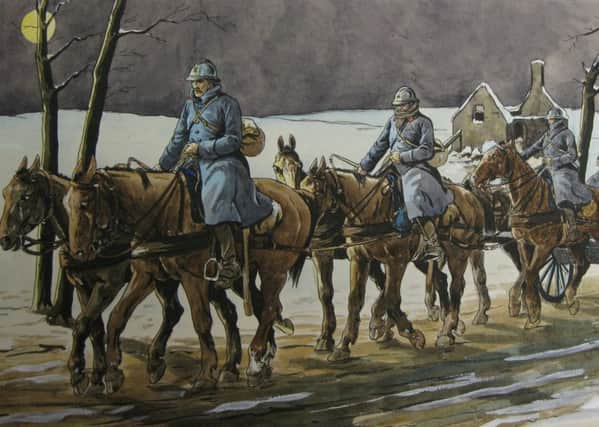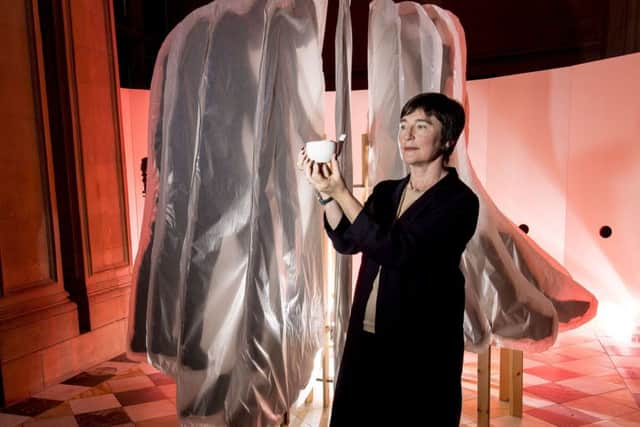Art reviews: Brushes With War | Christine Borland - I Say Nothing


Brushes with War: Art from the Front Line 14-18, Kelvingrove Art Gallery and Museum, Glasgow ***
Christine Borland: I Say Nothing, Kelvingrove Art Gallery and Museum, Glasgow ***
Advertisement
Hide AdThe First World War changed art, as it changed so much in the world. There was no shortage of artists, in the decades after 1918, grappling with the implications of loss and brutality on an unimaginable scale. More rare is art which captures these events as they were happening. At the time, the idea of an official war artist was still in its infancy, and the boundary lines between art and propaganda were awkwardly blurred. Those caught drawing or painting in the trenches without authorisation could have stood accused of spying.


However, many serving soldiers did depict their experience, as Brushes with War, an extensive exhibition at Kelvingrove, shows. The majority of these 219 works come from a single collection, that of American Joel Parkinson, who runs the World War History & Art Museum in Alliance, north-west Ohio. This is supplemented by small groups of works from Glasgow Museums’ collection by Fred Farrell – who was invalided out of the Army in 1916 and managed to get himself appointed Glasgow’s official war artist – and Percy Smith, an artist-soldier who produced drypoints in the trenches and created a powerful series of prints, Dances of Death, in 1919.
Farrell and Smith are exceptions, here, in that they identified themselves as artists with a clear mission to communicate what they saw to a wider audience. The majority of those featured in the exhibition were servicemen who drew and painted, almost always on a small-scale, using quick, portable materials such as pencils and watercolour. There are works here by British troops, German, French, Austrian, Russian, American and others, from watercolours by officers to sketches and cartoons by ordinary squaddies, with small sections on the Navy, the Air Force and field hospitals.
The artists depict what they see: their comrades, pieces of artillery, barren landscapes of mud and blasted trees, rows of bell tents. There are cartoons and caricatures, and the French emerge as the masters at this: Kaiser Wilhelm appears as Santa with a sack full of “balles dum dum” (expanding bullets, illegal under the 1899 Hague Convention).
In most cases, we don’t know what happened to these artists; in some cases, we don’t even know their names. They made their work for a variety of reasons, from amusing their comrades to filling their empty hours. Private Chester C Hyde drew postcards for his mother in Long Island, New York, showing the pretty towns and villages of Belgium and France as if no war was happening at all.
A few, however, had bigger intentions, such as Gunner FJ Mears, who wanted to show the war “as the soldier sees and not as seen by the conventional artist”. There are several works by Mears in the show, beautifully realised watercolours of dawn sorties and ravaged woods. Like many of the works here, they depict a world of semi-darkness – dawn, dusk, candlelight, or the gloom of a trench in dreich weather – which quickly takes on a symbolic significance.
Advertisement
Hide AdThose who depict what we understand as the horror of it all do so in a way which is matter-of-fact: Mears shows us the rats scurrying away from a dawn raiding party; Sous-lieutenant Roger Gueritot, in an evocative drawing On Patrol in the Trench, shows us men crouched in muddy hollows, wounded or just trying to sleep. Private Sidney Dennant Moss’s sketch Burying the Dead is poignant not because it shows us row upon row of crosses but due to the way it simply depicts a group of men digging a grave in the half-light, as if they did this every day.
The exhibition is arranged chronologically, from “Anticipation” in 1914, through “Stagnation,” “Attrition,” “Desperation” and finally, in 1918, “Determination,” but it has to be remembered that these terms were applied with hindsight. The scale of the show has its own relentlessness. One becomes aware of just how little there was to see, and how much of the time was spent, as one artist puts it, “waiting for something to happen”. In this way, it is a unique window into the First World War. These men were not naive about what they were living through; their pictures show the art of keeping going, putting one foot in front of the other, trying to live until the next day.
Advertisement
Hide AdThe art commissioned as part of the 14-18 NOW programme is this exhibition’s polar opposite. At a distance of 100 years, artists have responded to the themes of the First World War, creating surprising and stimulating responses, from Paul Cummins and Tom Piper’s poppy field – entitled Blood Swept Lands and Seas of Red – at the Tower of London to Jeremy Deller’s evocative We’re Here Because We’re Here, which saw thousands of volunteers dressed up as First World War soldiers suddenly materialise in locations all over the UK in 2016 to commemorate the centenary of the Battle of the Somme.
In Glasgow, Christine Borland’s I Say Nothing is a joint commission by Glasgow Museums and 14-18 NOW, supported by the Art Fund. After spending time exploring Glasgow Museums’ First World War collections, Borland has focused on a small object with an ambiguous history, the invalid feeder cup, used in hospitals to help wounded soldiers unable to feed themselves, but also, in the years immediately before the war, used to force-feed hunger-striking suffragettes. It’s an object she explored in her commission for Mount Stuart earlier this year, arguably with greater range.
Using the 19th century technique of “photosculpture” – a series of photographs taken in the round and used to create a sculpture, a sort of 3D printing for the 1860s – she has created two sets of images which show the cup in use, one in a caring context, the other as coercion. The wooden silhouettes are arranged in two circles, cloaked in glassine, a semi-transparent paper used in museum stores to protect artworks. The feeding cup used to make the work was exploded into fragments by a bomb disposal unit in Flanders which deals with First World War ordnance; some fragments are displayed in a glass case.
While these are highly evocative, the cumbersome silhouettes remain obscured, deliberately so, perhaps as the passage of time itself obscures the facts of history. Apart from in brief moments in which sunlight illuminates a shape, we can’t be sure what we’re looking at, who is involved, what is their intent.
Borland’s work is typically rigorous in its concepts, methods and materials, but visual impact is important too – perhaps all the more so in a high-profile work for a public collection responding to an important historic event. The work needs to say something visually which we don’t get from reading the supporting text.
Ironically, I Say Nothing feels like a work which has something to say, but deliberately hides in the shadows. In showing us how stories are obscured by time, its visual impact is frustratingly elusive.
Brushes with War until 6 January; Christine Borland: I Say Nothing is on permanent display